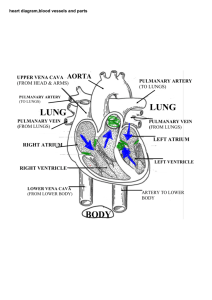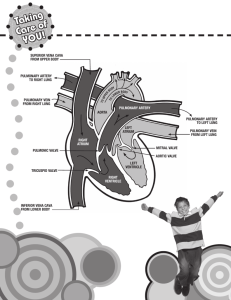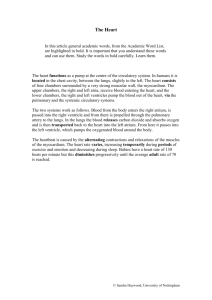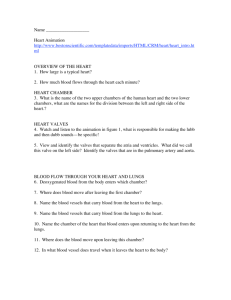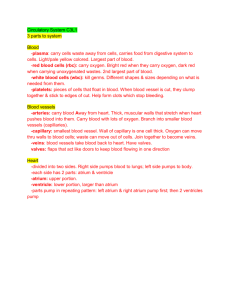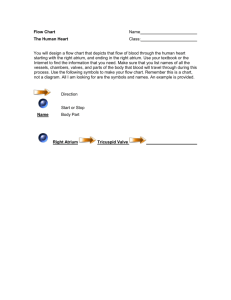Task Description: Heart & lung dissection
advertisement
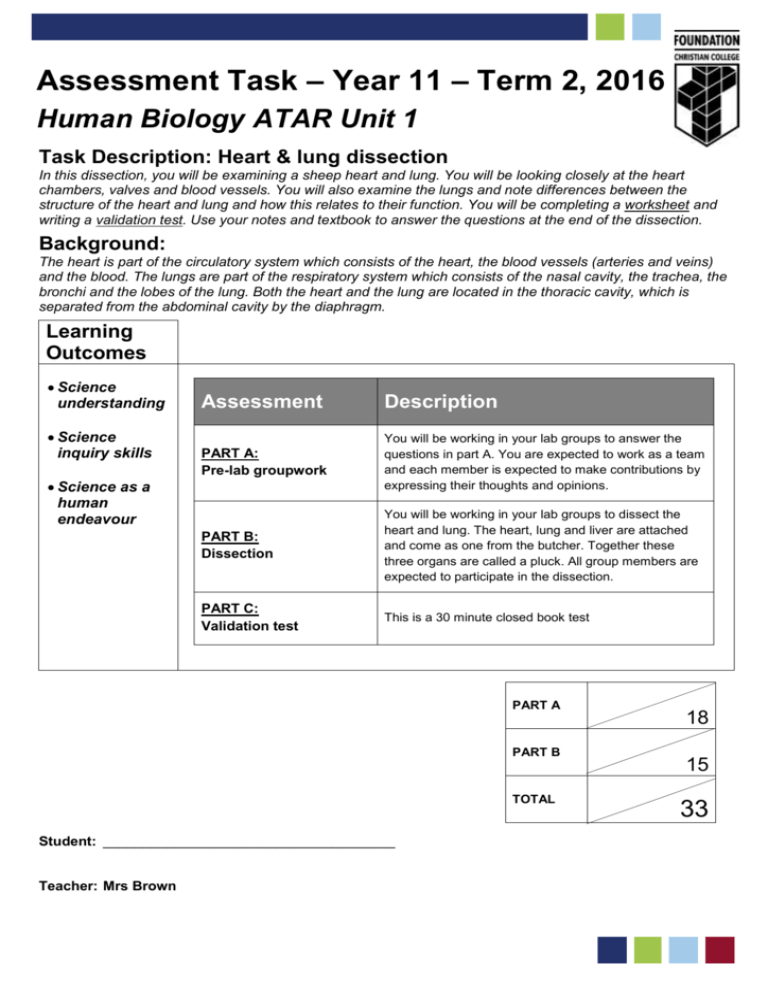
Assessment Task – Year 11 – Term 2, 2016 Human Biology ATAR Unit 1 Task Description: Heart & lung dissection In this dissection, you will be examining a sheep heart and lung. You will be looking closely at the heart chambers, valves and blood vessels. You will also examine the lungs and note differences between the structure of the heart and lung and how this relates to their function. You will be completing a worksheet and writing a validation test. Use your notes and textbook to answer the questions at the end of the dissection. Background: The heart is part of the circulatory system which consists of the heart, the blood vessels (arteries and veins) and the blood. The lungs are part of the respiratory system which consists of the nasal cavity, the trachea, the bronchi and the lobes of the lung. Both the heart and the lung are located in the thoracic cavity, which is separated from the abdominal cavity by the diaphragm. Learning Outcomes Science understanding Science inquiry skills Science as a human endeavour Assessment Description PART A: Pre-lab groupwork You will be working in your lab groups to answer the questions in part A. You are expected to work as a team and each member is expected to make contributions by expressing their thoughts and opinions. PART B: Dissection You will be working in your lab groups to dissect the heart and lung. The heart, lung and liver are attached and come as one from the butcher. Together these three organs are called a pluck. All group members are expected to participate in the dissection. PART C: Validation test This is a 30 minute closed book test PART A PART B TOTAL Student: _____________________________________ Teacher: Mrs Brown 18 15 33 PART A: Pre-lab groupwork 1. The structure of the heart and lungs reflect their function. Briefly state the function of each system and the corresponding tissue (heart) or functional unit (lung). Heart Function _________________________________________________________________ _________________________________________________________________ Cellular tissue _________________________________________________________________ Lungs Function _________________________________________________________________ _________________________________________________________________ Functional unit _________________________________________________________________ (4 marks) 2. Considering the function of the heart, what would you expect the tissue to look and feel like? ______________________________________________________________________________ ______________________________________________________________________________ (1 mark) 3. Considering the function of the lungs, what would you expect the tissue to look and feel like? ______________________________________________________________________________ ______________________________________________________________________________ (1 mark) 4. Considering that the circulatory and respiratory systems function together to supply the body with oxygen, what is the main feature that you would expect to see that would confirm this close association? ______________________________________________________________________________ ______________________________________________________________________________ (1 mark) 5. Briefly state (in order) four practical steps you will take to ensure that you are able to observe: how the heart and lungs fit together the shape of both organs the internal structure of both organs ______________________________________________________________________________ ______________________________________________________________________________ ______________________________________________________________________________ ______________________________________________________________________________ (4 marks) 6. A microscope is set up with a slide featuring a cross-section of some lung tissue. Carefully draw an accurate diagram of your microscope observations. If possible, identify structures such as bronchiole, alveoli and blood vessels. Include a title to your diagram. (5 marks) _______________________________________ 7. Look again at the tissue sample under the microscope. Observe how close the blood vessels are close to the wall of the alveoli. Why is this important? ______________________________________________________________________________ ______________________________________________________________________________ ______________________________________________________________________________ (2 marks) PART B: The dissection THE LUNGS (1 mark per question unless otherwise stated) Arrange the pluck so that the heart is beneath the lungs and the liver is below these two organs. Observe how they fit together. Identify the diaphragm. 1. The lung has two lobes. Why are the left and right lungs a different shape and size? ______________________________________________________________________________ ______________________________________________________________________________ ______________________________________________________________________________ Separate the heart, lungs and liver. Cut the blood vessels attaching the heart to the lungs at about 510 cm from the heart. Set the heart and liver aside. Take the lungs and follow these instructions, answering the questions as you go: 2. Make a lateral incision in the trachea with the scalpel (lengthwise down the middle). When it is cut open like this it springs open and lies almost flat. What is the function of the cartilage rings in the trachea? ______________________________________________________________________________ ______________________________________________________________________________ ______________________________________________________________________________ Keep cutting, following the airway as far as possible. When you can’t see the airway anymore, carefully cut a thin slice of lung tissue. Place the piece of tissue on a petri dish. View the slice under the stereo microscope 3. Alveoli are shaped as shown in the diagram to the right. Explain why this is more efficient for gas exchange than a smooth sphere. ______________________________________________________________________________ ______________________________________________________________________________ ______________________________________________________________________________ 4. How is air continually being replenished in the alveoli? ______________________________________________________________________________ ______________________________________________________________________________ ______________________________________________________________________________ 5. Where do the blood vessels enter and leave the lung? ______________________________________________________________________________ ______________________________________________________________________________ THE HEART Arrange the heart as shown in the diagram on the right. Identify the left and right side of the heart. Remember the left side of the heart should be on your right side as you look at the heart. Lay the heart with the apex closest to you and the groove with a blood vessel travelling diagonally from the right side of the wide part of the heart to a point just above and to the left of the apex. Identify the structures shown in the diagram. 6. Locate the arteries and veins that carry blood to and from the lungs and to and from the body. Identify two differences between these blood vessels. (2 marks) Arteries Veins 7. What is the white material around the top of the atria? What function might it have? ______________________________________________________________________________ ______________________________________________________________________________ ______________________________________________________________________________ Insert the four wooden skewers into each of the four main blood vessels of the heart. Try to identify each of these four blood vessels and the chambers of the heart that they lead to. THE RIGHT SIDE OF THE HEART Find the superior vena cava. This should be on the right side of the top of the heart and leads to the right atrium. Insert the dissecting scissors/scalpel and cut down through the heart until you reach the bottom of this chamber. Locate the valves that separate the atrium from the ventricles. Continue to cut down carefully through the heart valve into the right ventricle. Open the heart as much as possible to answer the following questions. 8. Identify and name the valves between the: (2 marks) Left atrium and left ventricle ____________________________________________________ Right atrium and right ventricle ____________________________________________________ 9. How do the heart valves function to regulate the direction of blood flow? _____________________________________________________________________________________ _____________________________________________________________________________________ _____________________________________________________________________________________ The valves separating the atria from the ventricles are anchored in the walls of the heart at the papillary muscles by the chordae tendinae (cords made of tendons). 10. Why are these cords important? _____________________________________________________________________________________ _____________________________________________________________________________________ _____________________________________________________________________________________ Try pulling one of these cords out of the muscle. 11. Why are the cords so strong? _____________________________________________________________________________________ _____________________________________________________________________________________ _____________________________________________________________________________________ 12. Why don’t the semi-lunar valves have cords? _____________________________________________________________________________________ _____________________________________________________________________________________ _____________________________________________________________________________________ Locate the valves of the pulmonary artery and cut upward until you reach the valves. Have another look at the whole of the right section of the heart. LEFT SIDE OF THE HEART Now insert dissecting scissors/scalpel into the blood vessel located at the top of the heart. This is the pulmonary vein. Cut down through the wall of the left atrium until you reach the apex. Open the left atrium and examine the valve that separates the atrium from the ventricle. Examine the ventricle, especially the walls. 13. What do you notice about the thickness of the walls of the right ventricle compared to the left ventricle? _____________________________________________________________________________________ _____________________________________________________________________________________ _____________________________________________________________________________________

